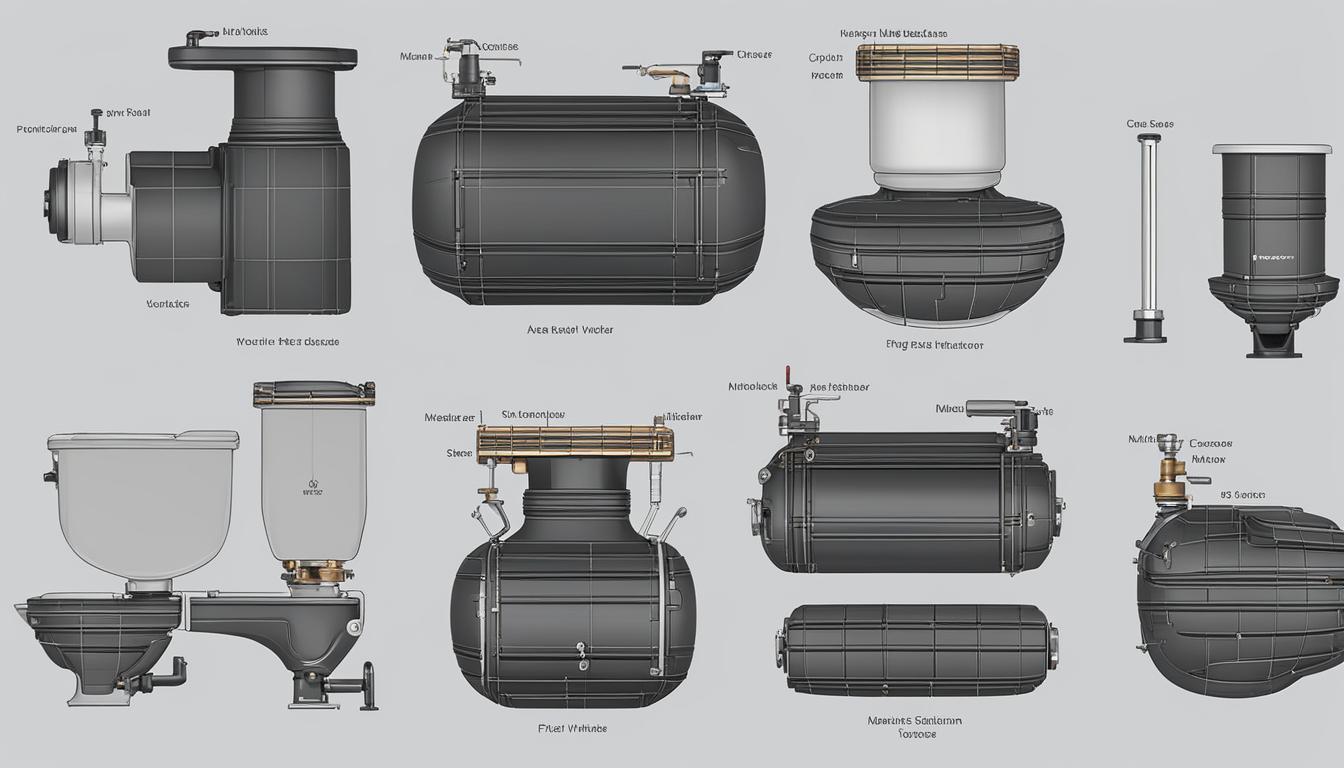When it comes to choosing a toilet for your bathroom, understanding the different types of toilet mechanisms is essential. From the flushing mechanisms to the valve types, each component plays a crucial role in the overall performance and efficiency of the toilet.
A toilet consists of various components, including the flush mechanism, toilet bowl, seat, and waste pipe. The flushing mechanism, such as buttons, levers, or chains, is responsible for initiating the flush. The valve types, including the fill valve and flush valve, control the flow of water during the flushing process.
There are different types of toilet mechanisms available, each with its own advantages and features. Dual flush toilets offer water-saving options, allowing for a half flush for liquid waste and a full flush for solid waste. Gravity flush toilets, the most common type, rely on the gravitational force to flush waste. Pressure-assisted flush toilets provide a powerful flush by using pressurized air. Siphonic flush toilets use the siphoning effect for efficient waste removal. Water-saving toilet mechanisms are designed to minimize water usage while maintaining effective flushing performance.
By understanding and considering the different types of toilet mechanisms, you can choose a toilet that meets your specific needs for water efficiency, flushing power, and overall performance.
Key Takeaways:
- Different types of toilet mechanisms include dual flush, gravity flush, pressure-assisted flush, siphonic flush, and water-saving mechanisms.
- The flushing mechanism, valve types, and toilet components all contribute to the overall performance of a toilet.
- Dual flush toilets provide water-saving options for different waste types.
- Gravity flush toilets are the most common and use gravity to flush waste.
- Pressure-assisted flush toilets offer a powerful flush using pressurized air.
- Siphonic flush toilets use the siphoning effect for efficient waste removal.
- Water-saving toilet mechanisms aim to minimize water usage without compromising flushing performance.
Toilet Types Explained
When it comes to choosing a toilet, there are several types to consider. Each type offers unique features and benefits that cater to specific needs. Let’s explore the different toilet types available:
Dual-flush Toilets
Dual-flush toilets are designed to conserve water by offering two flush options. They have a half flush for liquid waste and a full flush for solid waste. This innovative design helps save water and reduce utility bills.
Double Cyclone Flush Toilets
Double cyclone flush toilets utilize advanced flushing technology to provide an efficient and powerful flush while using less water. They use two nozzles instead of rim holes, creating a cyclone effect that effectively cleans the bowl.
Pressure-assisted Toilets
Pressure-assisted toilets use pressurized air to provide a strong and forceful flush. This mechanism allows for a thorough cleaning of the bowl, making them ideal for commercial or high-traffic areas that require frequent use.
Gravity-flush Toilets
Gravity-flush toilets are the most common type found in households. They rely on gravity to flush waste into the drainage system. These toilets are reliable, cost-effective, and easy to maintain.
Composting Toilets
Composting toilets are environmentally friendly and suitable for areas where traditional plumbing is not available. They decompose human waste through a biological process, creating compost that can be used as fertilizer.
Waterless Toilets
Waterless toilets, as the name suggests, do not require any water for flushing. They are an excellent option in areas with water shortage issues or off-grid locations. These toilets utilize innovative and odor-free systems to manage waste.
Upflush Toilets
Upflush toilets are a versatile option that eliminates the need for complex plumbing installations. They use a macerating unit to pump waste upward into the existing sewage line. These toilets are great for basement bathrooms and other locations where traditional plumbing is challenging.
Portable Toilets
Portable toilets are compact and convenient solutions for outdoor events, construction sites, and camping trips. They provide a sanitary and portable bathroom option, ensuring comfort and hygiene in areas without access to permanent toilet facilities.
Each toilet type mentioned above has its unique features and advantages. Understanding the different options available can help you make an informed decision when selecting the right toilet for your needs.
| Toilet Type | Key Features |
|---|---|
| Dual-flush Toilets | Two-flush options for water conservation |
| Double Cyclone Flush Toilets | Efficient and powerful flush with less water usage |
| Pressure-assisted Toilets | Strong and forceful flush using pressurized air |
| Gravity-flush Toilets | Rely on gravity for waste removal, cost-effective |
| Composting Toilets | Environmentally friendly, treat waste through biological process |
| Waterless Toilets | No water required, suitable for water-deficient areas |
| Upflush Toilets | Easy installation, pump waste upward |
| Portable Toilets | Compact and portable, suitable for outdoor use |
Common Toilet Styles
When it comes to toilet styles, there are several options to choose from. Each style has its own unique features and benefits, allowing you to find the perfect toilet that suits your needs and preferences. Here are some common toilet styles:
Two-Piece Toilets
A Two-Piece Toilet consists of a separate water tank and bowl. This design allows for easier installation and maintenance, as individual parts can be replaced if needed. It is a popular choice and widely available.
One-Piece Toilets
One-Piece Toilets have a seamless and compact design, with the tank and bowl seamlessly integrated into one unit. They are easier to clean and maintain, making them a convenient choice for many homeowners.
Back-to-Wall Toilets
Back-to-Wall Toilets have a contemporary style that saves space in your bathroom. The cistern is concealed behind the wall, giving a sleek and minimalist look to your bathroom.
Wall-Hung Toilets
Wall-Hung Toilets are modern and stylish, with the water tank built into the wall. The bowl appears to be floating, creating a sense of space and elegance. They are a great choice for smaller bathrooms as they save floor space and are easy to clean underneath.
High-Level Toilets
High-Level Toilets provide a traditional look with a cistern fitted high on the wall. This classic design adds a touch of vintage charm to your bathroom and gives a statement look.
Low-Level Toilets
Low-Level Toilets have a vintage look with the cistern fitted at a lower level, usually attached to the back of the toilet bowl. They are a popular choice for period-style bathrooms and can add a nostalgic touch to your space.
Choosing the right toilet style depends on your personal preference, the design of your bathroom, and the space available. Consider the aesthetics, functionality, and ease of maintenance when making your decision.
Flushing Mechanisms
Choosing the right flushing mechanism is crucial for both water efficiency and cleaning effectiveness in toilets. There are several popular flushing mechanisms available, each with its own benefits and considerations.
Gravity Flush
The gravity flush mechanism is the most common type found in residential toilets. It relies on the force of gravity to remove waste from the toilet bowl. When the flush lever is activated, water is released from the tank and flows into the bowl, creating a siphonic action that carries the waste down the drain. Gravity flush toilets are known for their simplicity, reliability, and water-saving features.
Dual Flush
The dual flush mechanism offers users the option of two types of flushes: a full flush for solid waste and a reduced flush for liquid waste. This mechanism allows for greater water conservation as users can select the appropriate flush based on the waste type, saving water in the process. Dual flush toilets are becoming increasingly popular due to their eco-friendly design and water-saving benefits.
Touchless Flushing
Touchless flushing mechanisms have gained popularity in recent years due to their convenience and hygiene benefits. These mechanisms are motion-sensor activated, allowing users to flush the toilet without touching any buttons or levers. By simply waving a hand in front of the sensor, the flush is activated, reducing the risk of cross-contamination and promoting a cleaner, more sanitary bathroom environment.
Flushometer Valve
Flushometer valves are commonly used in commercial settings and are suitable for tankless toilets. These valves deliver a powerful flush by quickly releasing a large volume of water directly into the toilet bowl. Flushometer valves are known for their robustness and ability to handle heavy use and high traffic environments, making them a popular choice in public restrooms and commercial buildings.
When selecting a flushing mechanism, consider factors such as water efficiency, ease of use, maintenance requirements, and compatibility with your specific toilet model. Choose a mechanism that suits your needs and preferences, ensuring a reliable and efficient flushing experience.
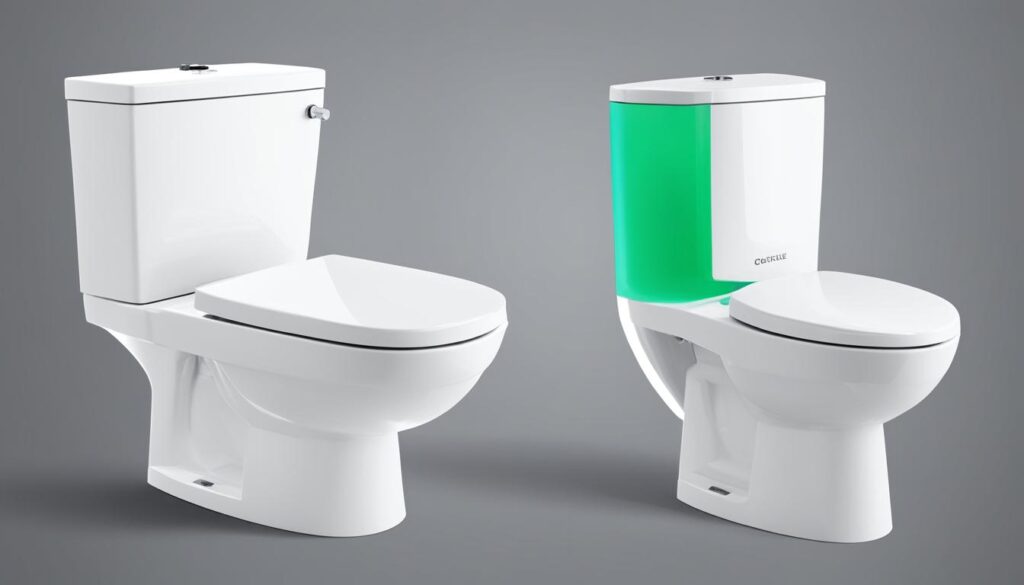
Toilet Fill Valve Types
The fill valve is a crucial component of a toilet’s flushing system, responsible for regulating the flow of water into the toilet tank. There are several types of fill valves commonly found in toilets, each with its own unique design and characteristics. Understanding the different fill valve types can help you make an informed decision when it comes to choosing the right one for your toilet.
Plunger/Piston Style Fill Valves
Plunger/piston style fill valves are constructed from heavy-duty cast brass and feature a floating ball attached to a pivoting lever. When the toilet is flushed, the ball rises, activating the valve and allowing water to fill the tank. Once the tank is full, the ball floats back down, closing the valve and stopping the water flow. This mechanism ensures a precise and reliable filling process.
Diaphragm Ballcocks
Diaphragm ballcocks rely on a diaphragm seal that opens and closes to control the flow of water. When the toilet is flushed, the diaphragm lifts, allowing water to enter the tank. As the tank fills up, the diaphragm lowers, closing the valve and preventing further water flow. Diaphragm ballcocks are known for their quiet operation and excellent water shut-off capabilities.
Float-Cup Fill Valves
Float-cup fill valves feature a plastic floating cup that moves up and down along the fill valve shaft. As the toilet is flushed, the cup rises, opening the valve and allowing water to flow into the tank. When the tank is full, the cup descends, shutting off the valve and stopping the water flow. Float-cup fill valves provide consistent performance and are highly resistant to clogs.
Pressure Assist System
A pressure assist system utilizes air and water to create a powerful flush. When the toilet is flushed, water is forced into the tank under high pressure, resulting in a forceful and efficient flush. These systems are commonly found in commercial settings where a robust flushing capability is required.
Vacuum Assist System
A vacuum assist system utilizes air suction to clean the toilet bowl effectively. When the toilet is flushed, a vacuum is created, pulling waste down and ensuring thorough cleaning. Vacuum assist systems are known for their water-saving capabilities and quiet operation.
| Fill Valve Type | Features |
|---|---|
| Plunger/Piston Style Fill Valves | Constructed from heavy-duty cast brass Reliable and precise filling process |
| Diaphragm Ballcocks | Diaphragm seal controls water flow Quiet operation and excellent shut-off |
| Float-Cup Fill Valves | Plastic floating cup regulates water flow Consistent performance and clog resistance |
| Pressure Assist System | Utilizes air and water for a powerful flush Ideal for commercial settings |
| Vacuum Assist System | Uses air suction for effective bowl cleaning Water-saving and quiet operation |
Choosing the right fill valve type for your toilet is essential for optimal flushing performance and water efficiency. Consider the specific needs of your household and the desired level of functionality when making your decision. With the right fill valve, you can ensure a reliable and efficient toilet flushing experience.
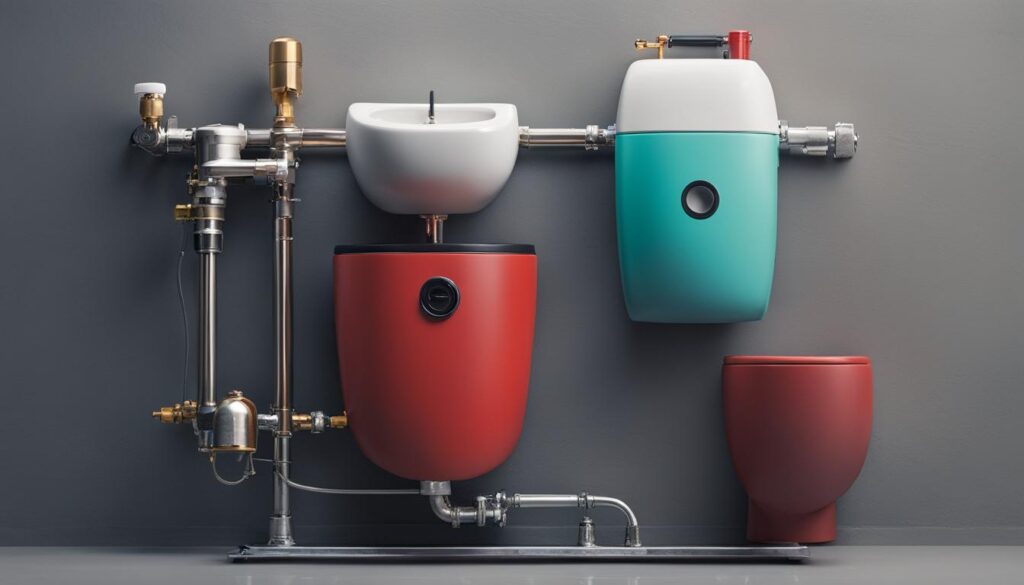
Pros and Cons of Different Flush Systems
When it comes to flushing systems, each has its own advantages and disadvantages. Let’s explore the pros and cons of different flush systems:
Gravity Flush System
- Pros:
- Affordable
- Cons:
- May require multiple flushes to clean the toilet bowl thoroughly
Dual Flush System
- Pros:
- Saves water
- Cons:
- Can be prone to clogs
Single Flushing System
- Pros:
- Simple and straightforward
- Cons:
- May waste water
Pressure Assist System
- Pros:
- Provides a powerful flush
- Cons:
- Can be expensive to install and repair
Vacuum Assist System
- Pros:
- Offers strong suction
- Cons:
- May be costly to maintain
Choosing the right flush system for your toilet depends on your specific needs and preferences. Consider the pros and cons mentioned above to make an informed decision.
| Flush System | Pros | Cons |
|---|---|---|
| Gravity Flush | Affordable | May require multiple flushes to clean the toilet bowl thoroughly |
| Dual Flush | Saves water | Can be prone to clogs |
| Single Flushing | Simple and straightforward | May waste water |
| Pressure Assist | Provides a powerful flush | Can be expensive to install and repair |
| Vacuum Assist | Offers strong suction | May be costly to maintain |
Considerations When Choosing a Toilet Mechanism
When selecting a toilet mechanism, there are several factors to consider to ensure you make the right choice for your needs and preferences.
1. Place and Purpose
Think about where the toilet will be installed and its purpose. Will it be for a residential bathroom, commercial space, or outdoor area? This will help determine the appropriate toilet type and style that fits the location.
2. Number of Users
Consider the number of users who will be utilizing the toilet. For households with many occupants or public spaces with high traffic, it may be best to opt for a toilet mechanism that can handle frequent use and has a durable construction.
3. Noise Level
If you value peace and quiet, consider the noise level of the toilet mechanism. Some toilets come with noise reduction features that can minimize the sound of flushing, making them suitable for bedrooms or areas where noise is a concern.
4. Budget
Set a budget for your toilet mechanism. Different types of toilets, flushing mechanisms, and fill valve types come at varying price points. Determine how much you are willing to spend to find a toilet that meets your needs without breaking the bank.
5. Septic Tank Compatibility
For houses with septic tanks, septic tank compatibility is essential. Ensure that the toilet mechanism you choose is compatible with your septic system to avoid any issues with waste disposal and plumbing.
By considering these factors, you can make an informed decision when choosing a toilet mechanism that suits your requirements and preferences.
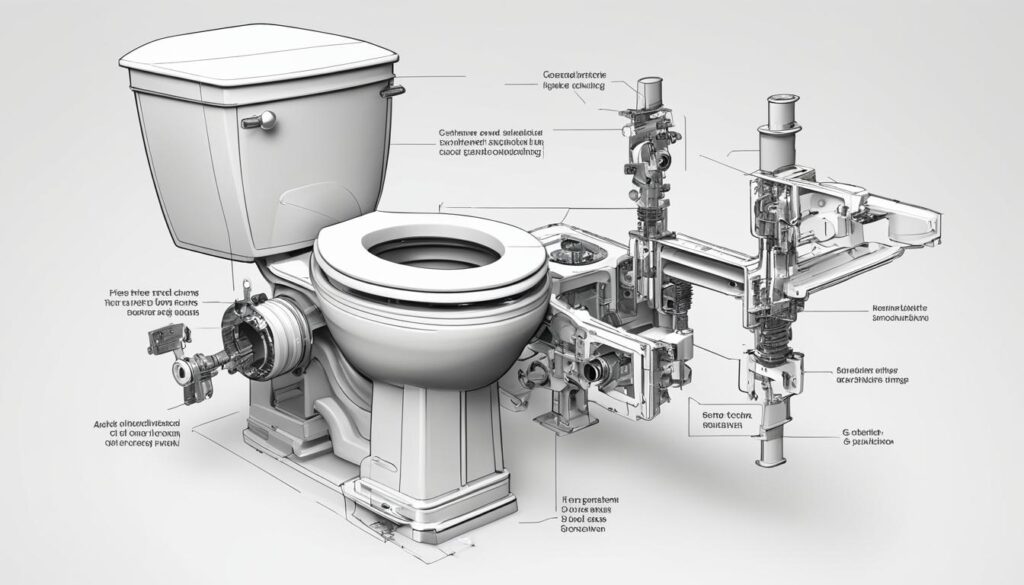
| Consideration | Description |
|---|---|
| Place and Purpose | Determine the location and purpose of the toilet to select the appropriate type and style. |
| Number of Users | Take into account the number of people who will be using the toilet to ensure it can handle the demand. |
| Noise Level | If noise is a concern, choose a toilet mechanism with noise reduction features. |
| Budget | Set a budget for your toilet mechanism to find options that fit within your financial means. |
| Septic Tank Compatibility | For houses with septic tanks, ensure the toilet mechanism is compatible with the septic system. |
Installation Costs of Toilets
When it comes to installing a new toilet, there are several factors that can affect the overall cost. These factors include the type of toilet, the location where it will be installed, and the labor costs involved. It’s important to consider these factors when budgeting for the installation of a toilet.
On average, the cost to install a toilet ranges from $200 to $500, depending on the complexity of the installation and any additional plumbing modifications that may be required. However, it’s worth noting that this is just a general estimate and the actual cost can vary.
Table: Cost Breakdown for Toilet Installation
| Expense | Average Cost |
|---|---|
| Toilet | $100 – $500 |
| Labor | $100 – $300 |
| Plumbing Modifications | $50 – $200 |
| Total | $250 – $1000 |
Additional Expenses
In addition to the basic installation costs, there may be additional expenses to consider. These can include the purchase of any necessary supplies and materials, such as wax rings, bolts, and water supply lines. If any plumbing repairs or modifications are required, this can also add to the overall expense.
It’s important to consult with a professional plumber to get an accurate estimate of the installation costs for your specific situation. They will be able to assess the existing plumbing and provide recommendations on any necessary modifications or repairs.
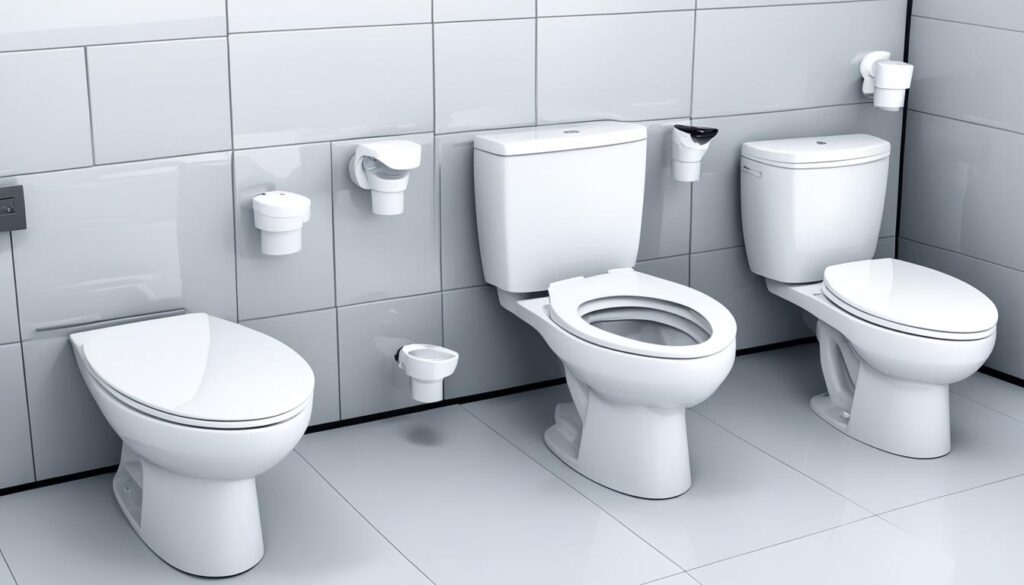
By budgeting for both the cost of the toilet itself and the installation expenses, you can ensure that you are prepared for the total cost of installing a new toilet. Taking these factors into account will help you make an informed decision and avoid any unexpected financial surprises.
Conclusion
When it comes to choosing the right toilet for your bathroom, understanding the different types of toilet mechanisms is crucial. From the flushing mechanisms to the toilet styles and fill valve types, there are various factors to consider.
By evaluating your specific needs and preferences, you can select a toilet mechanism that provides optimal efficiency and functionality. Whether you opt for a dual flush toilet, gravity flush toilet, pressure-assisted flush toilet, siphonic flush toilet, or any other type, it’s important to consider water-saving options and compatibility with your plumbing system.
With the right toilet mechanism in place, you can ensure a clean and efficient bathroom experience. So, take the time to research and choose wisely, and enjoy the benefits of a well-functioning toilet in your home.
FAQ
What are the different types of toilet mechanisms?
The different types of toilet mechanisms include dual flush toilets, double cyclone flush toilets, pressure-assisted flush toilets, gravity flush toilets, composting toilets, waterless toilets, upflush toilets, and portable toilets.
What are the common toilet styles?
Common toilet styles include two-piece toilets, one-piece toilets, back-to-wall toilets, wall-hung toilets, high-level toilets, and low-level toilets.
What are the different flushing mechanisms?
The different flushing mechanisms include gravity flush, dual flush, touchless flushing, and flushometer valve.
What are the different fill valve types in toilets?
The different fill valve types in toilets include plunger/piston style fill valves, diaphragm ballcocks, float-cup fill valves, pressure assist systems, and vacuum assist systems.
What are the pros and cons of different flush systems?
The pros and cons of different flush systems include the affordability and potential multiple flushes of gravity flush, water-saving options and potential clogs of dual flush, simplicity and potential water waste of single flushing, powerful flush and potential cost of installation and repair of pressure assist, and strong suction and potential cost of maintenance of vacuum assist.
What factors should be considered when choosing a toilet mechanism?
Factors to consider when choosing a toilet mechanism include the location and purpose of the toilet, the number of users, the noise level, the budget, and compatibility with septic systems.
How much does it cost to install a toilet?
The cost to install a toilet can range from $200 to $500, depending on factors such as the type of toilet, location, and labor costs. Additional expenses may be incurred for plumbing modifications or repairs.
What should I consider when choosing a toilet mechanism?
When choosing a toilet mechanism, it’s important to evaluate your specific needs and preferences, consider water-saving options, and ensure compatibility with your plumbing system.

